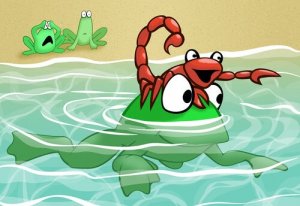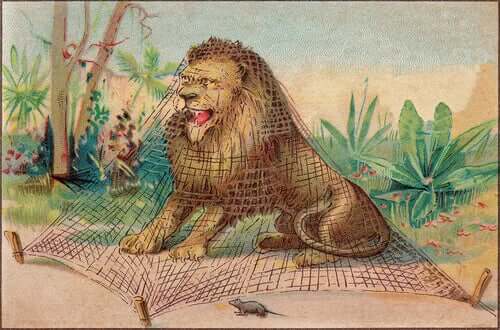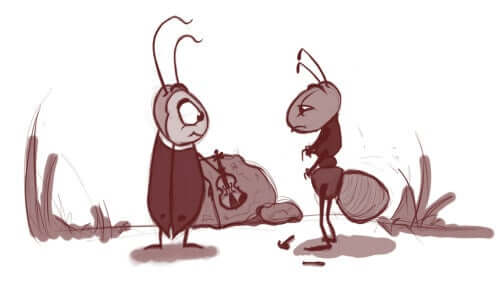4 Wonderful Animal Stories for Kids

Animal stories and fables are still one of the best ways out there to teach kids valuable lessons. This probably won’t be the first time you’ve heard of Aesop’s Fables, and you’ve probably already been reading some to your kids.
Aesop’s fables: great animal stories for kids
Aesop’s stories are still a big deal nowadays, and a major source of inspiration for children’s stories and cartoons. Aesop was a storyteller in Ancient Greece, and animals are almost always the main characters in his stories.
Although we don’t know much for certain about Aesop’s life, and we can only assume he was the creator of certain stories, there’s no doubt about his worldwide legacy.
Today, we’re going to show you some of his most worthwhile animal stories. They all have a valuable lesson that even we adults could stand to use in our lives!
1. The scorpion and the frog
The scorpion and the frog (the image at the top of the article) is definitely one of his most well-known fables. It starts with a frog in a river, and a scorpion that wants to cross. At first, the frog doesn’t want to help the scorpion because it’s afraid of being stung. The scorpion promises not to harm it, because if it stings the frog, they’ll both drown.
Just when they’re almost all the way across, the scorpion stings the frog. The frog can’t believe it, and says: “Why would you do that? Now we’re both going to die!” Then the scorpion simply responds: “I couldn’t help it. It’s in my nature.”
The moral of this story is not to deceive yourself into thinking that another person will act the way you would. Some people always do the same things, no matter the consequences of their actions. They are what they are, and they don’t seem like they’ll ever change.
2. The lion and the mouse
This fable has less of a bitter ending than the last one. A lion goes out hunting and catches a little mouse. The mouse begs the lion not to eat it. Surprisingly, the lion has pity and lets the mouse go.

Later on, the lion gets trapped under a hunter’s net. In fear for its life, it begs for help. Not long after, the mouse it let go appears and gnaws through the net to let it escape. The lion can’t be thankful enough, and offers the mouse its friendship.
This is one of our favorite animal stories for kids because it’s about not ruling people out because of the way they look. It also shows that good deeds go rewarded.
3. The ant and the grasshopper
In this fable, there’s a grasshopper that gets to enjoy the summer. It doesn’t work, and lies on leaves and sings the day away.

Any time it got hungry, it asked its neighbor, the ant, for food. The ant was a tireless worker. It was constantly collecting fruit and seeds so it would have a good stock for the winter.
The grasshopper made fun of the ant and said it wasn’t taking advantage of the summer, which wasn’t very smart. Then came the winter, and, with the colder temperatures, there wasn’t so much food.
The grasshopper couldn’t find anything to eat, and turned to the ant for help. But this time, the ant didn’t have enough food for both of them. The ant criticized it for being so lazy in the summer, instead of collecting food and preparing.
You’ve probably heard some version of this story before. Teachers and parents love to tell it as a lesson about how hard work pays off. Not working hard pays off in its own way too, but in a bad way.
4. The tortoise and the hare
This story has a similar message to the last one, and is probably one of the most famous of all Aesop’s fables. Here, a tortoise and a hare challenge each other to a race. The hare knows it’s much faster, and decides to sleep for most of the race. By the time it wakes up, the tortoise has already slowly made its way to the finish line.

The moral of this story is to not be arrogant. There are a lot of cases where the people you underestimate end up going much farther than you. They may be slow, but they’re consistent. This is also where we get the saying: “Slow and steady wins the race.”
As you can see, animal stories have some really great, compact lessons for you and your kids. The personified animals in these fables seem extremely familiar and human, and are a great teaching tool.
Animal stories and fables are still one of the best ways out there to teach kids valuable lessons. This probably won’t be the first time you’ve heard of Aesop’s Fables, and you’ve probably already been reading some to your kids.
Aesop’s fables: great animal stories for kids
Aesop’s stories are still a big deal nowadays, and a major source of inspiration for children’s stories and cartoons. Aesop was a storyteller in Ancient Greece, and animals are almost always the main characters in his stories.
Although we don’t know much for certain about Aesop’s life, and we can only assume he was the creator of certain stories, there’s no doubt about his worldwide legacy.
Today, we’re going to show you some of his most worthwhile animal stories. They all have a valuable lesson that even we adults could stand to use in our lives!
1. The scorpion and the frog
The scorpion and the frog (the image at the top of the article) is definitely one of his most well-known fables. It starts with a frog in a river, and a scorpion that wants to cross. At first, the frog doesn’t want to help the scorpion because it’s afraid of being stung. The scorpion promises not to harm it, because if it stings the frog, they’ll both drown.
Just when they’re almost all the way across, the scorpion stings the frog. The frog can’t believe it, and says: “Why would you do that? Now we’re both going to die!” Then the scorpion simply responds: “I couldn’t help it. It’s in my nature.”
The moral of this story is not to deceive yourself into thinking that another person will act the way you would. Some people always do the same things, no matter the consequences of their actions. They are what they are, and they don’t seem like they’ll ever change.
2. The lion and the mouse
This fable has less of a bitter ending than the last one. A lion goes out hunting and catches a little mouse. The mouse begs the lion not to eat it. Surprisingly, the lion has pity and lets the mouse go.

Later on, the lion gets trapped under a hunter’s net. In fear for its life, it begs for help. Not long after, the mouse it let go appears and gnaws through the net to let it escape. The lion can’t be thankful enough, and offers the mouse its friendship.
This is one of our favorite animal stories for kids because it’s about not ruling people out because of the way they look. It also shows that good deeds go rewarded.
3. The ant and the grasshopper
In this fable, there’s a grasshopper that gets to enjoy the summer. It doesn’t work, and lies on leaves and sings the day away.

Any time it got hungry, it asked its neighbor, the ant, for food. The ant was a tireless worker. It was constantly collecting fruit and seeds so it would have a good stock for the winter.
The grasshopper made fun of the ant and said it wasn’t taking advantage of the summer, which wasn’t very smart. Then came the winter, and, with the colder temperatures, there wasn’t so much food.
The grasshopper couldn’t find anything to eat, and turned to the ant for help. But this time, the ant didn’t have enough food for both of them. The ant criticized it for being so lazy in the summer, instead of collecting food and preparing.
You’ve probably heard some version of this story before. Teachers and parents love to tell it as a lesson about how hard work pays off. Not working hard pays off in its own way too, but in a bad way.
4. The tortoise and the hare
This story has a similar message to the last one, and is probably one of the most famous of all Aesop’s fables. Here, a tortoise and a hare challenge each other to a race. The hare knows it’s much faster, and decides to sleep for most of the race. By the time it wakes up, the tortoise has already slowly made its way to the finish line.

The moral of this story is to not be arrogant. There are a lot of cases where the people you underestimate end up going much farther than you. They may be slow, but they’re consistent. This is also where we get the saying: “Slow and steady wins the race.”
As you can see, animal stories have some really great, compact lessons for you and your kids. The personified animals in these fables seem extremely familiar and human, and are a great teaching tool.
This text is provided for informational purposes only and does not replace consultation with a professional. If in doubt, consult your specialist.








